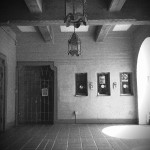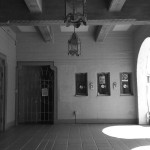
Original and processed by Monochromia
.
Monochromia
Version 1.1.0
Price: $1.99
![]()
Bottom Line: Spotty full-res support and noisy, blown out monochrome conversions make this a disappointing app.
 I love shooting for monochrome. I love discovering a killer app that takes my images and converts them to gorgeous black & white, with smooth gradients while holding the shadow detail and not blowing out highlights. I also love apps that replicate the look of analog film.
I love shooting for monochrome. I love discovering a killer app that takes my images and converts them to gorgeous black & white, with smooth gradients while holding the shadow detail and not blowing out highlights. I also love apps that replicate the look of analog film.
Monochromia, a new black & white conversion app from youthhr, really excited me when I first saw it in the app store. However, the actual results from the app don’t look nearly as pretty as the sample images in iTunes and in its early releases. Monochromia disappoints.

Monochromia screenshot
Monochromia is fairly easy to use. Photos can be shot within the app and can also be imported from your iPhone’s camera roll. There are three onscreen sliders to adjust for Contrast, Brightness, and Vignette. Hidden way in the app’s prefs are additional settings for Film Simulation, Gamma Adjustment, Ultra High Contrast, and “Fuzzy Mode”.
The conversion was pretty disappointing. Highlights were blown out. Conversion added a lot of noise and artifacts to the shadows. Gradients were pretty patchy. Depending on the settings, mids blew out a lot as well, washing out much of the detail of the image. This is with the default settings and with Ultra High Contrast turned off.
Fuzzy Mode didn’t work as expected. Rather than enhance the noise or grunge up the image a little bit, Fuzzy Mode seemed to adjust the gamma without effecting the noise levels very much.
Monochromia really wanted to add simulated film grain to my images and there was no way to turn it off. “Film grain” in the form of noise was added even though I had switched the setting off in the app’s prefs. I felt that the film grain effect was way too noisy. It wasn’t a subtle film grain effect like with the excellent ClassicToy camera series from misskiwi. Monochromia’s looks harsh and like someone cranked the Add Monochromatic Noise filter in Photoshop. A good film grain simulation should be subtle and should only add a hint of texture — not beat you over the head with it. I also noticed sometimes the app introduced odd noise artifacts that weren’t in the original image. See the gallery below for full-size examples.
Rather than make my images look like beautiful monochromes, Monochromia made my images look more like badly photocopied pictures.
Monochromia does not save the original image, only the processed one. Monochromia saves at a maximum resolution of 1200×1600, which is perfect for an iPhone 2G or 3G, okay for a 3GS, but unacceptable for a new iPhone 4, which has a resolution of 5 MP. It saves images at a maximum width of 1200 pixels, so a tall portrait image will save at 1200×1600 but a landscape image only saves at 1200×900 pixels. An odd quirk. These issues need to be addressed in a future update.
Monochromia is not beyond saving. The resolution needs to be improved. The glitches need to be fixed. I think the app needs a better, more subtle conversion algorithm — one that preserves more of the shades and details of the image. Let the details obliterate in Ultra High Contrast mode, but in standard mode I’d like to see the app be a bit more nuanced in its conversions, like the excellent MonoPhix apps. The level of noise in the film grain effect needs to come way down. More variation in the gray levels would probably help as well.
There are other monochrome conversion apps that are versatile in their conversion parameters and produce much better results. Both MonoPhix and FilmLab produce nicer looking grayscales and also have the ability the create stunning, high contrast images. Monochromia isn’t ready yet — unless your creative goal is a noisy, gritty black and white picture.
App Store link: Monochromia
=M=
~~~~
Related links: MonoPhix | FilmLab
- Monochromia screenshot






